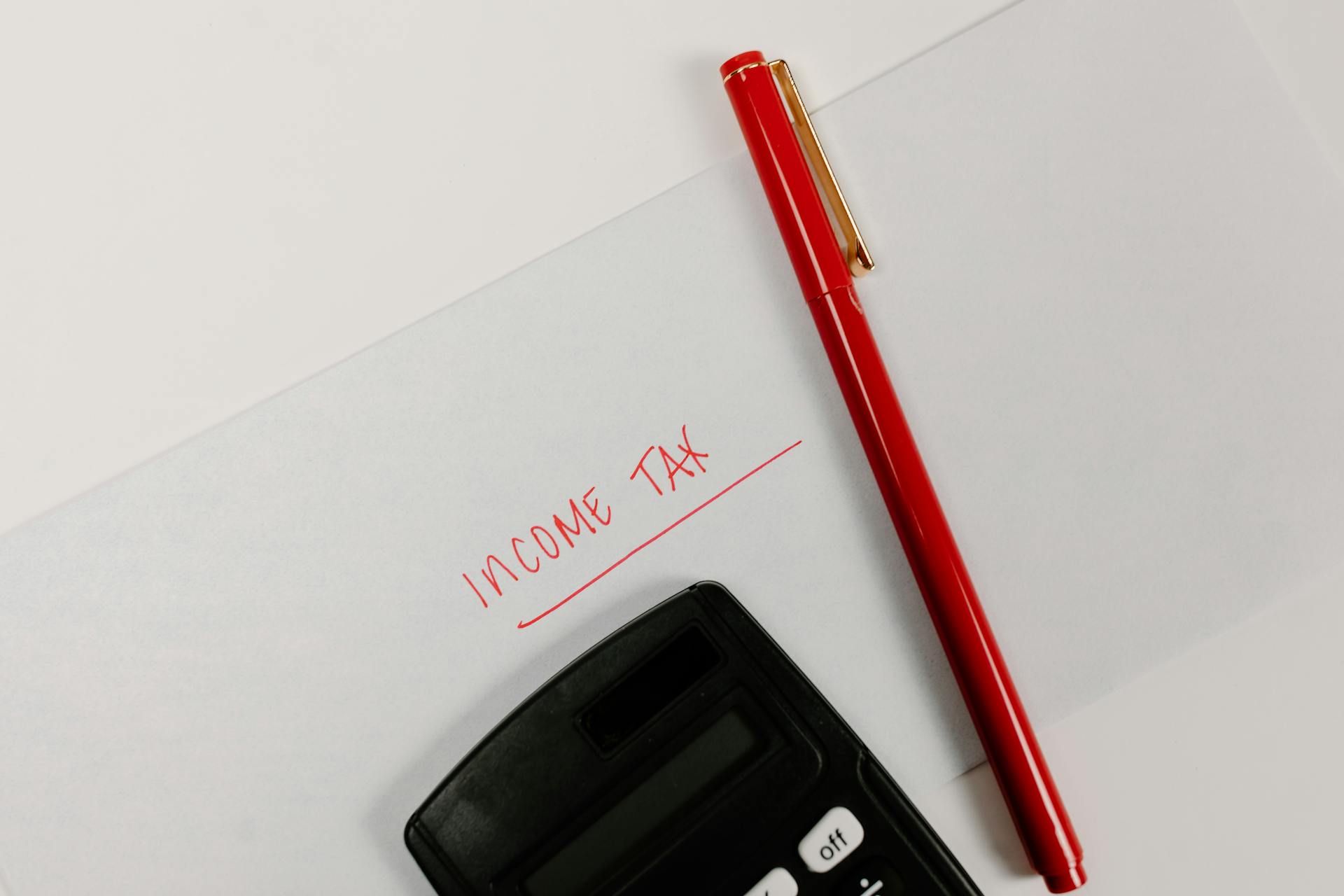
Calculating NoPAT requires a clear understanding of its components, including operating income, interest expense, and taxes. NoPAT is a more accurate measure of a company's profitability than net income.
To start, you'll need to calculate operating income, which can be found on a company's income statement. Operating income is the profit a company makes from its core business operations.
Interest expense is another key component of NoPAT, which can be found on a company's income statement as well. This includes interest paid on loans and other debts.
By subtracting interest expense from operating income, you can get a more accurate picture of a company's profitability before taxes.
Here's an interesting read: How to Find the Growth Rate of a Company
What Is NoPAT
NOPAT, or Net Operating Profit After Tax, is a financial metric that represents a company's operating profit after deducting taxes. It's a crucial aspect of measuring a company's economic profit and operational performance.
NOPAT is calculated by subtracting taxes from operating profit, which is the revenue generated from a company's core operations minus the operating expenses. This figure represents the company's earnings before interest and taxes (EBIT).
To calculate NOPAT, you need to start with the company's EBIT, determine the applicable tax rate, calculate the tax expense, and then subtract the tax expense from the EBIT.
Here's a simplified equation to calculate NOPAT: NOPAT = EBIT × (1 – Tax Rate). For example, if a company's EBIT is $210 million and the tax rate is 35%, the NOPAT would be $137 million.
NOPAT provides a more accurate measure of a company's profitability compared to other metrics like net income, as it focuses solely on the profit generated from the company's core operations, excluding any financial activities or one-time events that may distort the overall picture.
NOPAT is an essential metric for companies that operate in multiple jurisdictions, as it allows them to compare their profitability across different regions without being impacted by tax distortions.
Here are some key insights to help you understand NOPAT:
- NOPAT is a more accurate measure of a company's profitability than net income.
- NOPAT can be used to identify areas where a company can reduce its operating expenses or increase its revenue.
- NOPAT can be used to calculate a company's NOPAT margin, which is a measure of a company's operating profitability.
By understanding NOPAT, investors and analysts can gain a deeper understanding of a company's true operational profitability and make more informed investment decisions.
Calculating NoPAT
Calculating NOPAT is a straightforward process that involves several steps. You start by calculating the company's operating profit, which is the revenue generated from its core operations minus the operating expenses. This figure represents the company's earnings before interest and taxes (EBIT).
To calculate NOPAT, you need to determine the applicable tax rate based on the company's jurisdiction and tax laws. You then calculate the tax expense by multiplying the EBIT with the tax rate. Next, you subtract the tax expense from the EBIT to obtain the NOPAT.
It's essential to note that NOPAT provides a more accurate measure of a company's profitability compared to other metrics like net income. This is because it focuses solely on the profit generated from the company's core operations, excluding any financial activities or one-time events that may distort the overall picture.
Here's a simple formula to calculate NOPAT:
NOPAT = EBIT × (1 - Tax Rate)
If this caught your attention, see: How to Calculate Interest Tax Shield
For example, if EBIT is $10,000 and the tax rate is 30%, the net operating profit after tax is $7,000 (calculation: $10,000 x (1 - 0.3)).
NOPAT is a critical metric used to assess a company's operational profitability and efficiency. It's often used in conjunction with other metrics, such as capital employed, to calculate Economic Value Added (EVA).
Here are some key points to keep in mind when calculating NOPAT:
- Start with the company's operating profit (EBIT)
- Determine the applicable tax rate
- Calculate the tax expense by multiplying the EBIT with the tax rate
- Subtract the tax expense from the EBIT to obtain the NOPAT
- Analyze the NOPAT to assess the company's operational profitability and efficiency
By following these steps and using the correct formula, you can accurately calculate NOPAT and gain a deeper understanding of a company's true operational profitability.
Understanding NoPAT
NOPAT, or Net Operating Profit After Tax, is a company's theoretical after-tax operating income if it had no debt in its capital structure. It's a measure of a company's operating profitability, excluding the impact of taxes.
NOPAT is calculated by subtracting taxes from operating profit, which is the revenue generated from a company's core operations minus operating expenses.
Recommended read: How to Calculate Capital Gains Taxes
To calculate NOPAT, you need to start with the company's operating profit, which is the revenue generated from its core operations minus operating expenses. This figure represents the company's earnings before interest and taxes (EBIT).
The tax rate is usually based on the prevailing tax laws and regulations in the company's jurisdiction.
NOPAT provides a more accurate measure of a company's profitability compared to other metrics like net income. This is because it focuses solely on the profit generated from the company's core operations, excluding any financial activities or one-time events that may distort the overall picture.
Here are the steps to calculate NOPAT:
1. Start with the company's operating profit (EBIT).
2. Determine the applicable tax rate based on the company's jurisdiction and tax laws.
3. Calculate the tax expense by multiplying the EBIT with the tax rate.
4. Subtract the tax expense from the EBIT to obtain the NOPAT.
For example, if a company's EBIT is $210 million and the tax rate is 35%, the NOPAT would be $137 million.
NOPAT is a capital structure-neutral metric, which means it ignores the net interest expense. This makes it a more accurate measure of a company's operating profitability.
Explore further: How Is Sales Tax Calculated on a Car Lease
Here's a summary of the NOPAT formula:
NOPAT = Operating Income × (1 – Tax Rate)
Where:
- Operating Income = Gross profits less operating expenses
- Tax Rate = The applicable tax rate based on the company's jurisdiction and tax laws
By using NOPAT, investors and analysts can gain a deeper understanding of a company's true operational profitability and make more informed investment decisions.
NoPAT in Financial Models
NOPAT is used in the DCF model as a component of Unlevered Free Cash Flow, as demonstrated in the Walmart file. In 99% of cases, NOPAT is used in this way.
You could use NOPAT in other ways, such as turning it into a valuation multiple (Enterprise Value / Net Operating Profit After Taxes, or abbreviated to TEV / NOPAT). However, almost no one uses this in real life.
NOPAT is also useful when calculating returns-based metrics such as ROE, ROA, and ROIC. This is because NOPAT is capital structure-neutral, making it a reliable measure of a company's ability to generate profits from its core activities.
Debt capacity can also be assessed using metrics like Debt / NOPAT or NOPAT / Interest. However, these are much less common than metrics based on EBITDA or Free Cash Flow.
In 99% of cases, NOPAT is used in the DCF model as a component of Unlevered Free Cash Flow.
Take a look at this: For What Is the Coupon Rate Used to Compute
Noopat Example
Calculating NOPAT is a straightforward process. To get started, you'll need to know the company's operating income before interest and taxes, also known as EBIT, and the tax rate.
You can use the following formula to calculate NOPAT: NOPAT = EBIT x (1 - Tax Rate). For example, if EBIT is $10,000 and the tax rate is 30%, the net operating profit after tax is 0.7, which equals $7,000. This is an approximation of after-tax cash flows without the tax advantage of debt.
To calculate NOPAT, you can also start from net income. First, you'll need to work your way from net income to EBIT by adding back interest expense and taxes. Then, you can use the same formula: NOPAT = EBIT x (1 - Tax Rate). For instance, if EBIT is $210m and the tax rate is 35%, the NOPAT is $137m.
Here's a simple table to help you understand the calculation:
Note that the impact of debt financing is ignored in NOPAT, which means that the interest tax shield is removed. This makes NOPAT a more accurate measure of a company's operating profitability.
Key Concepts and Considerations
Net operating profit after tax (NOPAT) is a key metric for evaluating a company's operational efficiency. It's essential to understand what NOPAT measures and how it's calculated.
NOPAT excludes tax savings from existing debt and one-time losses or charges, providing a more accurate picture of a company's operational performance. This is crucial for mergers and acquisitions analysts who use NOPAT to calculate the free cash flow to firm (FCFF) and economic free cash flow to firm.
NOPAT is used to determine the efficiency of a leveraged company's operations.
For your interest: How to Calculate the Value of the Firm
Special Considerations
In addition to providing a measure of core operating efficiency, analysts use net operating profit after tax to calculate free cash flow to the firm (FCFF), which equals net operating profit after tax, minus changes in working capital.
Analysts also use net operating profit after tax in the calculation of economic free cash flow to the firm (FCFF), which equals net operating profit after tax minus capital.
Expand your knowledge: Net Operating Cash Flows Formula
There are different ways to calculate net operating profit after tax, including net income plus net after-tax interest expense (or net income plus net interest expense) multiplied by 1, minus the tax rate.
Analysts may also look at the business' profitability using net operating profit less adjusted taxes (NOPLAT).
Analysts primarily use these measures when looking for acquisition targets, as the acquirer's financing will replace the current financing arrangement.
These measures can provide valuable insights into a company's financial health and operating efficiency, helping investors and analysts make informed decisions.
Intriguing read: How to Calculate Debt and Equity Financing
Key Takeaways
Net operating profit after tax (NOPAT) is a key metric for evaluating a company's operational efficiency. It's a more accurate measure than traditional profit metrics, as it excludes tax savings from existing debt and one-time losses or charges.
NOPAT is particularly useful for mergers and acquisitions analysts, who use it to calculate the free cash flow to firm (FCFF) and economic free cash flow to firm. This helps them make informed decisions about potential deals.
Here are the key takeaways from our discussion on NOPAT:
- NOPAT measures the efficiency of a leveraged company's operations.
- NOPAT excludes tax savings from existing debt and one-time losses or charges.
- Mergers and acquisitions analysts use NOPAT to calculate FCFF and economic FCFF.
Frequently Asked Questions
Is NOPAT the same as Ebita?
No, NOPAT and EBITDA are not the same, as NOPAT is after-tax and accounts for depreciation, while EBITDA is pre-tax and includes non-operating income
Is NOPAT the same as EBT?
No, Net Operating Profit After Taxes (NOPAT) is not the same as Earnings Before Taxes (EBT), as NOPAT includes interest expenses in its calculation, making it a slightly more comprehensive measure of profitability
Sources
- https://www.carboncollective.co/sustainable-investing/net-operating-profit-after-tax
- https://fastercapital.com/topics/calculating-net-operating-profit-after-tax-(nopat).html
- https://www.investopedia.com/terms/n/nopat.asp
- https://www.wallstreetprep.com/knowledge/nopat-net-operating-profit-after-tax/
- https://breakingintowallstreet.com/kb/valuation/nopat/
Featured Images: pexels.com


